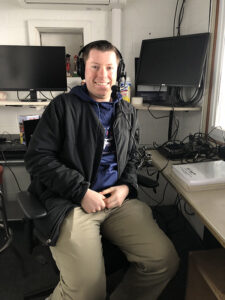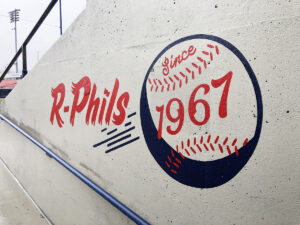
The Reading Fightin Phils continue to improve their 73-year-old venue while preserving the spirit of baseball and its history. FirstEnergy Stadium is well worth a visit for any Phillies fan.

Jake Starr
Jake Starr’s business card lists his occupation with the Reading Fightin Phils as “Media Relations.” It neglects to mention that he’s the team’s broadcast announcer.
Minor league baseball teams keep their staff busy. But Starr clearly doesn’t mind.
At just 24, the voice of the Fightin Phils already shows remarkable professionalism. He’s not just a great ambassador for Reading baseball, he can tell you quite a bit about the roster too.
Like many fans in the region, he has fond memories of being a kid at FirstEnergy Stadium. On a rainy Saturday morning, as would-be National Anthem singers try out in the background, he shares a couple with this observer.
“When I was nine,” he remembers, “our local little league, we raised the most money for our Bat-a-Thon. The reward was we got tickets to the Reading Phillies game. We got to introduce ourselves down on the field and go out and catch in the outfield. That was a really cool experience, getting to do that at a professional baseball stadium.
As far as Phillies stars that he’s seen play, “One notable name I remember in 2016 was Rhys Hoskins. It was cool to look back and think, I saw Rhys Hoskins when he was in Reading.”
He can easily rattle off names of recent Reading players he thinks could be fixtures at Citizens Bank Park soon.
“Johan Rojas got called up to the big leagues right from here last year. I think he’s gonna be a Gold Glove center fielder. Orion Kerkering was here last year, and he pitched some big innings in the postseason. I think he has a chance to be the Phillies closer by the middle of the season.
“Mick Abel, one of our top pitching prospects, has a chance to crack the big leagues this year. Griff McGarry, another guy who’s in a similar boat. Carlos de la Cruz, he’s like 6’8”. When he gets a hold of one, it travels far.”
What about players coming up to Reading?
“I think the big name is Justin Crawford, who finished here and at Jersey Shore. If he plays up to his potential, he’ll definitely get here at some point this year, barring a trade. You think Johan Rojas is fast, Justin Crawford’s right there with him.”
This town of 95,000, 70 miles west of Philly, is not just a place to enjoy a ballgame. It’s also where a fan can witness future stars of Philadelphia baseball.
For 57 summers and counting.
In an age of increasingly disposable ballparks…heck, in an age of disposable minor league teams…it’s not easy to find a venue that has been standing since 1951.
The Fightin Phils website shares a detailed history of FirstEnergy Stadium. Here’s the Reader’s Digest version:
Professional baseball has been played in Reading…off and on…since 1875. Lauer’s Park at 3rd and Elm was the home of local baseball until 1941 when poor attendance caused the departure of the Reading Brooks. Just two years later, Lauer’s was unceremoniously demolished.
But the city didn’t give up on bringing baseball back, and in 1945 the City Council voted to buy 27 acres of land in Cathedral Heights to build a shiny new ballpark.
Incidentally, taxpayer-funded sports venues weren’t any more popular in 1950 than they are today. You can find a Reading Eagle article online about the construction. The headline: “Mayor in Stadium Speech Raps Critics for Lack of Vision”. That mayor, Henry Stump, claimed…perhaps correctly in hindsight…that Reading would be a “backward city” without organized baseball.
The story also quoted an American Legion member asserting that “the great sportsmanship developed on the athletic fields of America helped the U.S. gain victory in World War II.”
With images of the Nazis storming through Poland still fresh in American minds, maybe American Legion members were entitled to make that point. In fact, the city named Reading Municipal Memorial Stadium for our war heroes. Ultimately, the new ballpark came in at $656,000.
Despite its proximity to Philadelphia, it was actually the Cleveland club whose minor league affiliate called the venue home at first. The Reading Indians played ten seasons there before leaving abruptly, to be replaced by a Red Sox affiliate for two years. The Indians then returned for one campaign before leaving for Pawtucket. Suddenly, Reading’s growing status as a forward city was in danger again.
Finally, in 1967, someone in the Phillies’ front office smacked his head and said, “Wait…what about putting our minor league team here? Isn’t it only 80 minutes from Philadelphia?”
After a dozen-plus years of observing the revolving door in Reading, the Phillies saw the obvious benefit of placing their AA affiliate in a town where residents were likely Phillies fans. They even boldly called the team the Reading Phillies, in case anyone missed the connection.
However shaky Reading baseball was for a decade and a half, the idea worked out. The Fightin Phils…who changed their name in 2012…today share the record for the longest affiliation with a major league club, with the Lakeland Flying Tigers and Detroit Tigers.
Today, FirstEnergy Stadium is more than thirty years older than any other ballpark in the Eastern League, so the initial price tag has been quite the bargain. Initial investment aside, though, the team and city have poured plenty more capital into making FirstEnergy Stadium a terrific home for baseball…and they’re still going.
Craig Stein, who bought the team in 1987, was one of those owners fans wish for…someone dedicated to improving the fan experience on every level. In 1989, the wooden benches were replaced with actual seats, and a roof was added to cover many of those seats in the rain and summer sun. The team also added a picnic area and a food court. By 1993, there was a new grandstand in right field.
There’s a long list of other improvements over the years. A souvenir shop, an irrigation system, a batting tunnel, and a left field bar overlooking the field. The new irrigation system has reduced the average number of rainouts per season from ten to three. Your 90-minute drive from Philly in the threatening clouds is now much more likely to be worth it.
Yet with all the improvements and modernization, a fan can easily attend a game and truly feel like little has changed about Reading baseball. The old-fashioned signage in the concourses, the monuments to the history, the brick façade, and the overall atmosphere in the seating bowl can transport any of us to a simpler time when baseball helped us forget the world’s troubles. It’s not just baseball when you were a kid; it’s baseball when your father was a kid.
Maybe in the 1950s, the scoreboard wasn’t capable of 68 billion colors. But the renovations honor the past too…like the exploding train that lights up and shoots fireworks when the Fightins plate a run. There’s no better way to remind everyone of Reading’s role in Monopoly.
A wise man (my father) once told this scribe while at a minor league contest, “These guys are professional ballplayers. If you hang a curveball in this league, they’re gonna hit it.”
A Fightin’ Phils game offers all that’s great about attending a baseball game…being out at the ballpark during a warm summer evening, living the excitement of spectacular fielding plays, stolen bases, swinging strikeouts, and walk-off home runs. Fans cheering on the home team as they take the field, fun activities for the kids, and of course, hot dogs that taste better than a steak at the Ritz.
As Jake Starr points out, there are even some advantages to a minor league game over the Show.
“I think it’s the intimacy of the experience,” he says of the appeal of minor league baseball. “You just feel closer to the action. You sit ten rows up behind home plate, and you feel like you’re there, you can feel the crack of the bat. It’s something you don’t get at big league ballparks.”
Best of all, of course, it comes at a fraction of the cost. “Maybe get two general admission tickets, a couple of hot dogs and sodas, you’re spending 30 bucks for the day.”
The only noticeable difference is that the names on the roster aren’t household names…yet. Once players become known in Reading, it’s the locals’ last chance to witness them being part of the local baseball community…one of us…before everyone in greater Philadelphia wants a piece of them.
“Two years ago,” Starr adds, “Bryson Stott was signing autographs for, say, a nine-year-old kid here. That kid now in middle school can watch Bryson Stott and know, ‘Hey, I met him.’”
The city of Reading got it right with their new ballpark in 1951, especially considering, as Starr correctly points out, that the major league club has twice replaced its home since then.
Reading may be “Pretzel City” to outsiders and Wikipedia editors. But for the townsfolk who spend their summer evenings in FirstEnergy Stadium, it’s Baseballtown.

Famous Reading Alumni
A game at Reading is your opportunity for your kid to get an autograph (or selfie) with a future Phillies star before it becomes much more difficult to do. There is a long list of ballplayers who made a name for themselves in Baseballtown before they became stars in South Philadelphia:
Larry Bowa (1967-68) – After being thrown out of the first game he played with a scout in attendance, Bowa played four years in the minors before making the Phillies squad, including 155 games in Reading.
Mike Schmidt (1971) – It only took 74 games at Reading before the major league club recognized Michael Jack’s talents. In his professional debut, he played for the big league Phillies against his soon-to-be teammates…and hit the game-winning home run (below).
Mickey Morandini (1989) – Morandini rose through the Phillies’ ranks quickly, and not just because everyone knew they would love hearing Harry Kalas say his name. He spent just 48 games at Reading, but in that short time, he batted .351 with five home runs.
Scott Rolen (1995-96) – The 1997 NL Rookie of The Year spent 81 games in Reading, putting up insane numbers in 1996. His .361 average and 33 extra base hits in 61 games earned him a quick promotion to Scranton-Wilkes Barre.
Jimmy Rollins (1999) – The 2007 National League MVP played 133 games in Reading, batting .273 and leading the team in games and at-bats (at right).
Ryan Howard (2004) – The NL Rookie of The Year and MVP played 102 games for the Reading team. He hit 37 home runs that year, setting a single-season team record.
There are many more household names in Philly that passed through Reading along the way: Boone, Burrell, Nola, Ruiz, Lieberthal and many others. You never know who’s going to be the next star at Citizens Bank Park, so go meet your Reading Fightin Phils now. You may own a valuable autograph of one someday.

